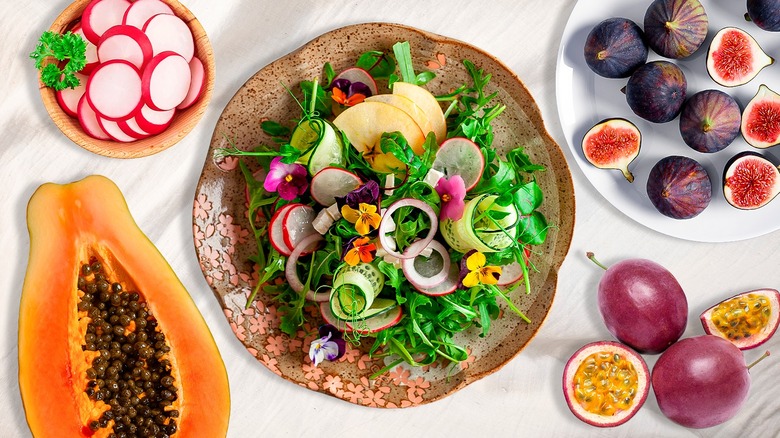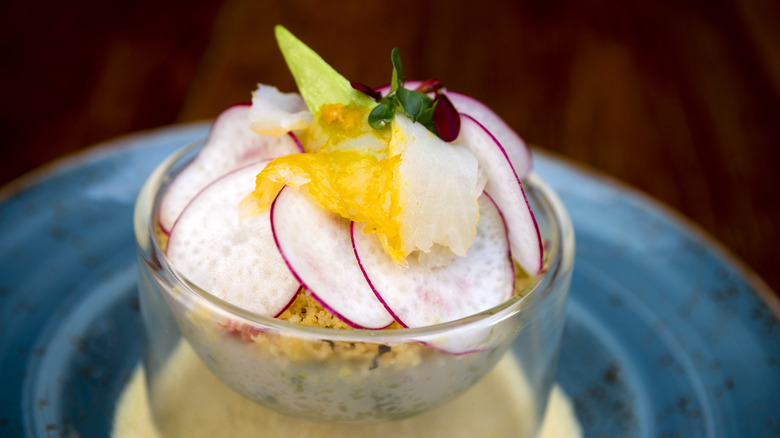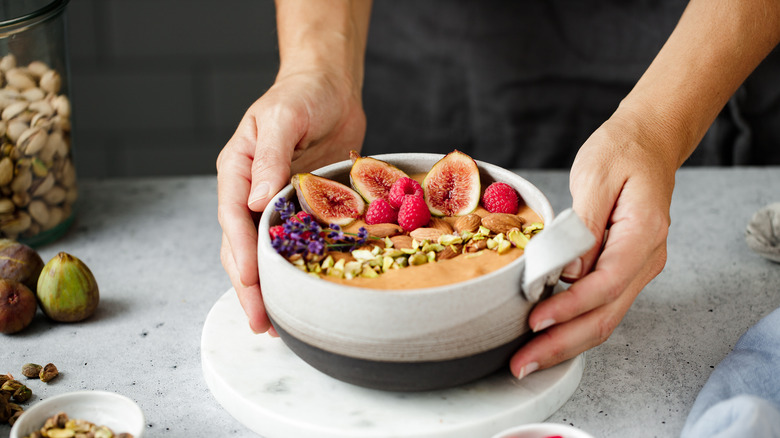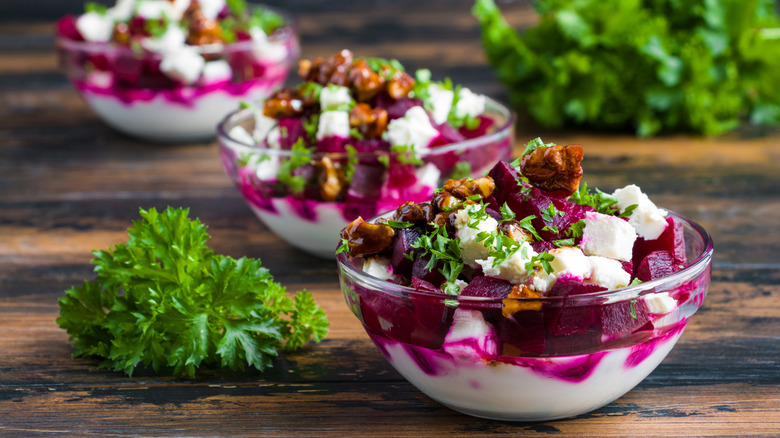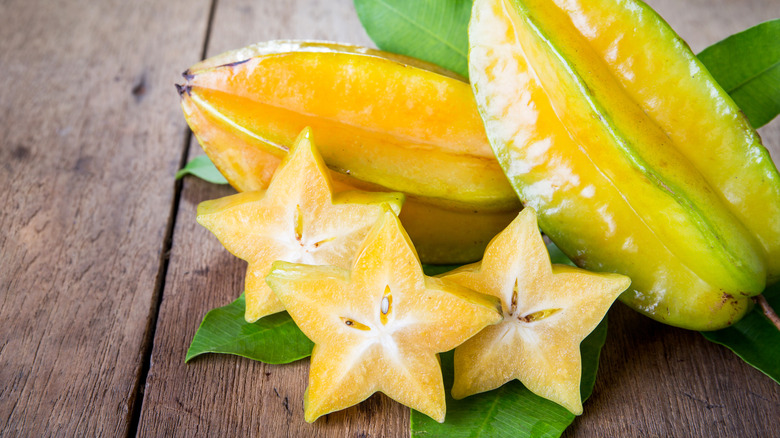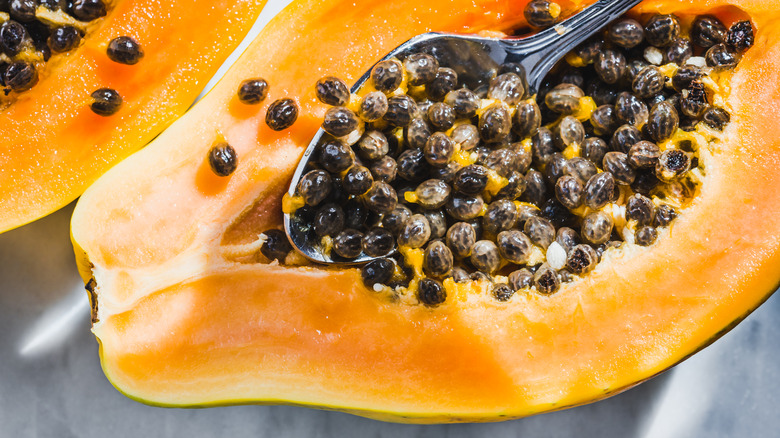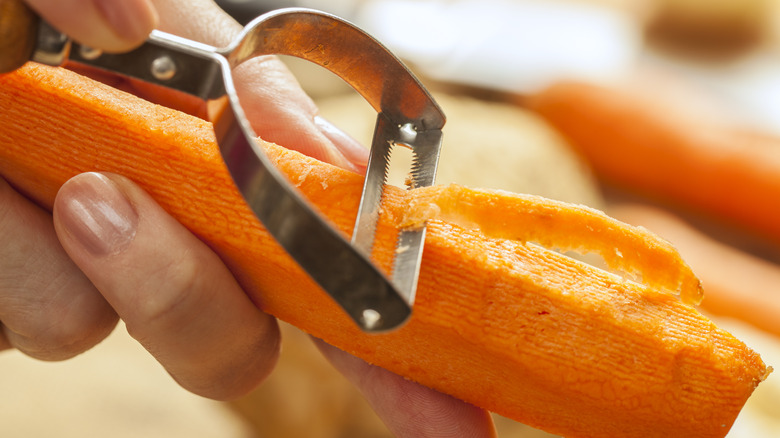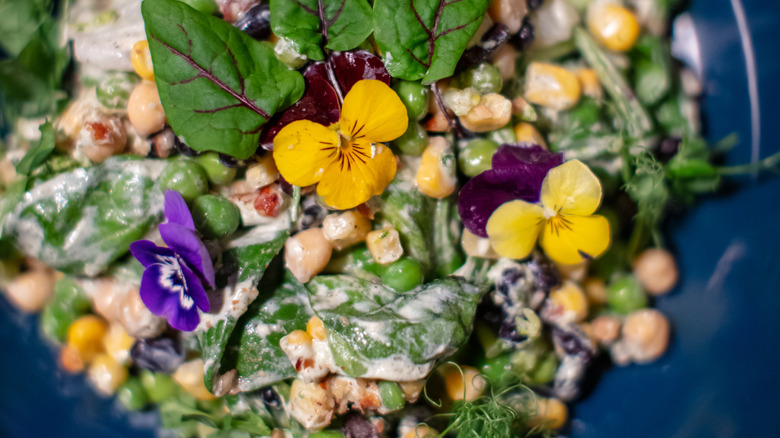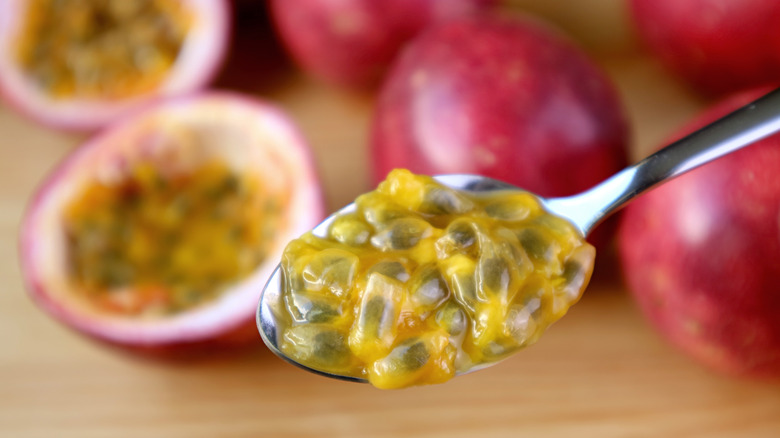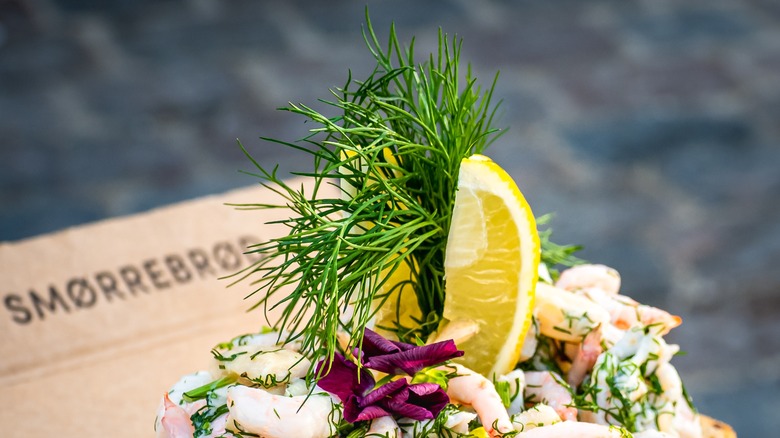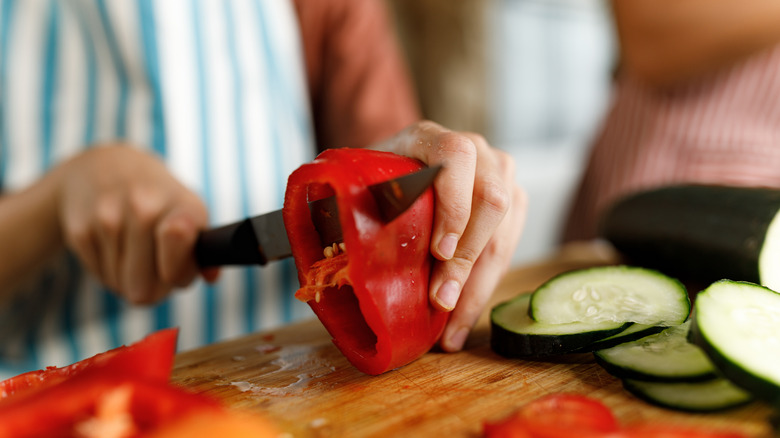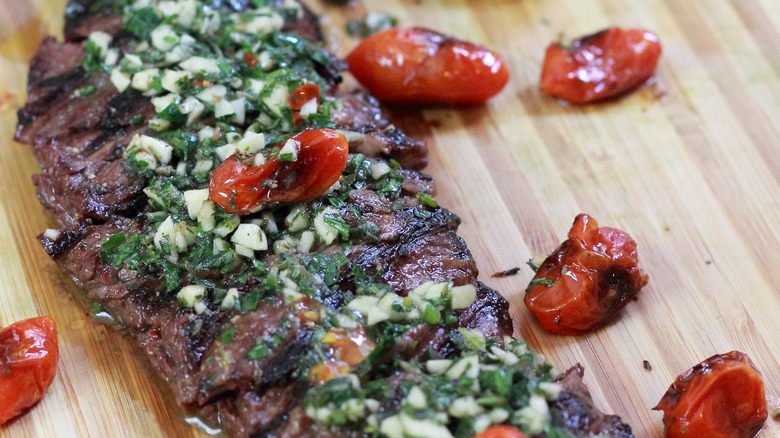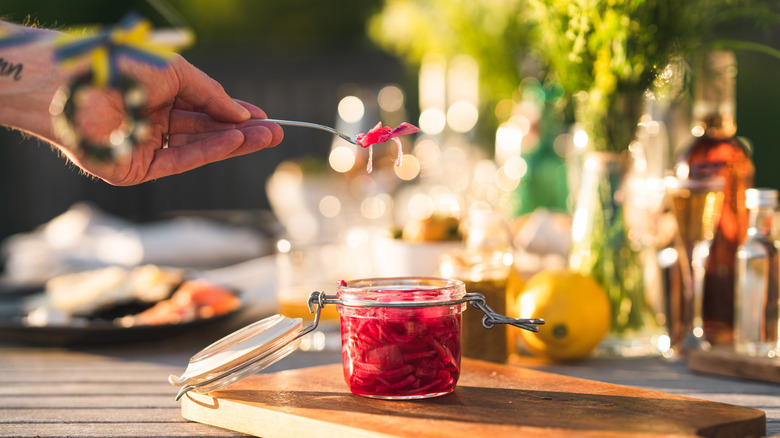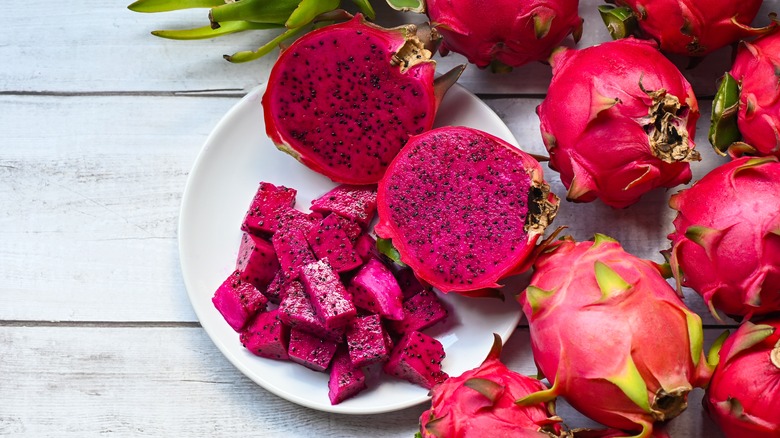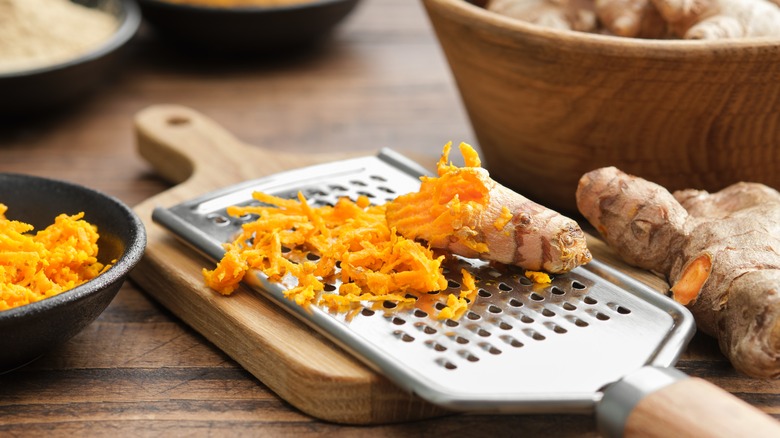15 Creative Ways To Use Fruits And Vegetables To Upgrade Your Springtime Meals
Although deep down, we know the most important culinary element is flavor, who can resist an aesthetically pleasing, Instagram-worthy dish? That drizzle of olive oil can add a subtle splash of color to a white plate. Freshly cracked black pepper can add texture. And, of course, a sprig of herbs can make any dish look fresh. A well-plated meal will have your mouth watering before the food even touches your lips. Spring is a great time to take advantage of colorful produce to enhance the aesthetics of your dish. Here's how you can get creative and use fruits and vegetables to upgrade your spring meals.
Start by going over some basic meal-plating tips. This will give you an understanding of where exactly to smear that sauce or how to top meals with delicate chives. Garnishing should make for a simple, beautiful plate presentation without leaving a dish cluttered or overpowering the main element. This is why colorful fruits and vegetables, when added properly, can add a splash of artistic beauty and sprinkle in some whimsy. Grab your gardening gloves, or hit the local farm stand or co-op, and let's get started.
Grilled citrus
Citrus fruits are used as a garnish across cultures because of their bright coloring and ability to enhance a meal's existing flavors. You may find lime wedges in Asian or South American cuisine, and lemons in Mediterranean cuisine. Even your basic American diner breakfast may come with an orange wedge. Now, in order to upgrade this popular garnish in both flavor and aesthetic, we recommend introducing it to a little heat.
Choose citrus that grows in the region from which your dish originates. Cut a few cross-sections of your fruit, slicing in between the stem and base. Use tips and tricks for grilling fruit, like ensuring that the grill is perfectly clean so the fruit doesn't stick and pre-heating the grill to create those nice char marks. Grilled fruit is a perfect way to upgrade your springtime meals because it adds a pop of color, warmth, and a burst of tangy flavor. The juice will only get sweeter with heat, and the grill can add a smoky element to balance the tart notes. Use grilled citrus alongside meats, fish, vegetables, warm bowls, or salads. The result? Colorful sophistication.
Thinly sliced radishes
Although radishes may not be a staple of your household, they are incredibly flavorful, versatile, and particularly beautiful. Radishes come in many varieties, each with their own color palette. The most common is the red radish, also known as the table or round radish. This is the small red radish you can find fairly easily in a generic grocery store. In contrast, the watermelon radish has a white outside, a pink center, and sometimes green highlights near the skin. A beautiful way to use them to garnish your plate is to simply slice them thin and sprinkle, layer, or fan out the slices.
There are many out-of-the-box ways you can cook with radishes, like pickling, roasting, pan frying, grilling, or enjoying them raw. Raw radishes are spicy, fresh, crunchy, and peppery and can add nice visual and flavor diversity to a meal as a garnish. Their vibrant coloring and fresh flavor align particularly well with a springtime aesthetic.
Raw fresh figs
I know what you're thinking. Who in their right mind would use those brown, shriveled, sunken fruit for a garnish? We often see figs in their dried form, but fresh figs are not only beautiful but decadently delicious. Their rich purple skins contrast beautifully with their bright pink interior. They utter pure sophistication and, although sweet, are amenable to both savory dishes and desserts.
In fact, the absolute best way to enjoy figs is fresh. They have a nectar-like flavor, balancing the line between a ripe strawberry and a date with a subtle tart kick. Besides their particularly sweet flavor, figs are the perfect balance between juicy and crunchy, adding texture. It's important to eat them soon after they have been harvested, as this is when their flavor peaks. When slicing figs, use a sharp knife to create cross-sections or halve them to exhibit their beautiful interior. Meals with darker earthy tones like red meats or roasted vegetables tend to pair nicely with figs, but they can also be used to add depth and darker tones to spring salads alongside crisp leafy greens.
Raw beets and their juice
When it comes to colorful vegetables, beets tend to catch the eye and take the cake. They are so intensely bright that they can be used to dye fabrics, so keep your clothing protected while working with them! Although they can come in yellow and orange tones, we recommend taking advantage of those deep pinkish-purple varieties that are standard in most grocery stores. Typically, we recommend roasting beets to bring out their natural sugars, but it's nice to add a little crunch to the mix when it comes to garnishes.
Vigorously scrub or peel your beet to get off all of the dirt and remove the thin skin. This will help keep the color consistent and bright. Use a peeler to shave off thin slices of the root vegetable, or use an exceptionally sharp knife. Because raw beets are tough, you can get creative by cutting out designs like stars or diamonds, but a half-moon or organic shape will tell a more sophisticated story. For a tangier flavor and softer crunch, opt for pickled beets. Save any juices you create from slicing or pickling the purple veggie to drizzle on your white plate, mix into your dressing, or splatter for a Jackson Pollock-style appearance. Because beets are so bright, limit how many slices or how much juice you use. It should accent, not overwhelm.
Starfruit in salads
Springtime is a season rich in color, life, and vibrancy. We believe that a playful splash of visual whimsy is just what you need to elevate any dish as we move out of a dark winter slumber. Our favorite playful produce is starfruit, which, when cut into sections, resembles a classic five-point star. Not only is the fruit star-shaped, but it is also star-colored with a subtle yellow hue.
Starfruit is fragrant, understated, and has a honey-like sweetness. It closest resembles a ripe pear in flavor, with a green grape-like tartness and texture. We recommend cutting it into quarter-inch slices and serving it over fresh, raw, or chilled dishes, like on top of a salad or floating in a watermelon gazpacho. It's essential to pick ripe starfruit so you can capitalize on its natural sugars. Look for a bright yellow fruit that has aged out of having an overwhelmingly green coloring. Enjoy starfruit as a garnish with monotone-colored foods so that it has a chance to shine.
Papaya
Tropical fruits are notorious for being bright, fresh, and beautiful, and papaya is no exception. Its pastel pinkish-orange flesh is soft, sweet, and an easy crowd-pleaser. Use papaya slivers in your springtime dish as a garnish to add some life and color. Because papaya flesh is sweet and subtle, it won't overpower the main focus of your dish. It pairs well with most other fruits and vegetables but particularly with tropical cuisine.
Luckily, this popular fruit offers more than just those fruity slices. Papaya seeds are edible and feature many health benefits associated with their consumption. So, for those who have always scraped those slimy black pepper-like seeds into the compost, stop throwing out papaya seeds! The peppery seeds are edible and subtly spicy and can add a unique and sophisticated look — a vegan caviar — to both sweet and savory dishes. Try using a spoonful of fresh papaya seeds on top of your grilled pork, steak, or vegetable platter. Anything that pairs well with cracked black peppercorns will taste wonderful with papaya seeds. Out of context, it may be difficult for your friends and family to guess what your mystery garnish is, which makes it that much more impressive and unique.
Rainbow carrot ribbons
The standard, classic carrot is famous for its beta-carotene-orange coloring, which is beautiful all on its own. But did you know carrots come in a range of colors, including yellow, red, white, and even purple? These rainbow carrots can be used to make beautiful garnishes that can top just about any recipe.
Carrots can be sliced into thin disks and act as polka dots to add pops of color. However, we love using a peeler to make ribbons. Simply peel your carrot, then continue to create long peels that will naturally curl. Grab a handful of the ribbons and allow them to support each other as you place them delicately on top of your dish. Root vegetables are naturally sweet and can be paired with both robust and gamey meat dishes as well as light, garden-fresh, raw vegetables. Go one step further and make pickled carrot ribbons to add a palate-cleansing tangy flavor that will induce mouth-watering reactions. Choose colored carrots that coordinate with your dish, or use a combination for a rainbow-like garnish.
Flowers
To brighten up our home in the spring, we automatically reach for a bouquet of fresh flowers. When it's time to brighten up your plate, why not do the same? Many flowers are edible; it's just important to choose a safe variety to adorn your plate and make it pop. Classically, edible flowers are used in salads because they have a similar texture and grassy-like flavor. This is the one dish we recommend not holding back on color or variety. Don't worry about overpowering the other ingredients because the flowers will become the main focus of your dish, and that's okay.
Another dish that's excellent with flowers is soup, especially colorful bisques or chilled soups. Drizzle your soup with high-quality extra virgin olive oil, add a little texture with toasted pine nuts, crumbled croutons, or roughly shaved parmesan, and finally, add three to five small flowers or one larger flower, off-center. Channel lilies on a flourishing pond, similar to a Claude Monet painting, and let your creativity shine.
Passionfruit
Passionfruit is just as beautiful on the inside as on the outside. With a green, yellow, or purple exterior, this sweet and seedy fruit typically has black seeds encased by a jelly-like bright yellow pulp. These seeds can be scooped out and used as a garnish. First, be sure you are working with a ripe fruit to ensure maximum flavor. The best way to tell if passionfruit is ripe and ready to eat without cracking it open is by checking its weight. If heavy, that fruit is filled with a water-dense, juicy interior. If it's light, then that center has not quite developed.
A simple way to use passionfruit as a garnish is by scooping out those seeds and dripping them over the center of your plate. Let it pool so that the seeds and pulp are mostly together, with some dripping down the sides of the food in the center. You can also slice a passionfruit in half and stack the halves on the side of a plate, slightly askew, so the connoisseur can scoop out little bits of the fruit to enjoy between bites. This presentation is especially nice for meat-heavy dishes, giving the diner a sweet and tangy palate cleanser while contrasting texture and temperature.
Lacy dill weed
Fresh dill weed are incredibly delicate and whimsical and can upgrade the appearance of your springtime meals. If you're familiar with common types of herbs, then you may already have fresh dill weed growing in your kitchen or garden or know where to buy it. Before you grab a bunch and take a knife to it, consider garnishing your meal with a full, lacy leaf of dill weed. It has an almost nautical-like appearance, so it pairs beautifully in flavor and visual aesthetics with seafood.
We also enjoy fresh dill leaves on top of light-colored foods like white beans, soft cheeses, sourdough toast, poultry, and white sauces or spreads. Its feathery appearance has a natural, sun-soaked forest-like appeal that can add personality to a filet of salmon or white bean spread. When in doubt, use it like a doily against a white plate, with the main focus of your dish spooned or placed on top. Be sure to set it off-center, especially if your cut of meat or pile of vegetables will be placed in the center of the dish. It should peak out dominantly on one side to add charm and sophistication.
Pepper cross-sections
Anyone who enjoys vegetables knows that peppers are the ultimate colorful vegetable. Depending on the stage of the pepper, you can choose any color ranging from deep green to bright red. That's right, for most grocery store bell peppers, aging makes the difference in the color of bell peppers, not variety. Chopped bell peppers can add a confetti-like appearance, especially with a combination of colors. However, using a thin cross-section is a more unique way to incorporate raw peppers as a garnish.
Simply cut the peppers between their stem and base to create rings. These rings will be misshapen in the most glorious ways. Layer three to five of these disks on your plate, or fold and stack them to create a sculpture-like appearance with some height. Use multiple colors or choose a color that best coordinates and stands out from your dish.
Charred cherry tomatoes
Nobody likes to bite into a whole cherry tomato in their salad. However, charred cherry tomatoes are broken down enough that their juices won't squirt onto your white shirt, and their sugars have had a chance to sweeten with the heat. The charred skins have a smoky, roasted flavor that's irresistible, and the deep red coloring with charred marks makes for the ultimate springtime garnish.
Char cherry tomatoes on your grill or in the broiler. Enjoy hot or cold, over salads, or stacked on roasted meat dishes. Tomatoes have sweet yet acidic notes and can add a punch of flavor and color without overpowering the main event. The longer you cook them, the sweeter they get. Although you can use both cherry and grape tomatoes, cherry tomatoes tend to be sweeter and juicer. Both come in a variety of colors, but the classic red makes quite an impression.
Pickled red onion
Both raw and roasted red onions have garnished a plate or two in their day. They are naturally sweet, tangy, and powerful, and their bright pink-red layers catch the eye. For an even brighter and more pronounced flavor, consider pickling red onions before adding them to your springtime meal as a garnish.
When making your own pickled red onion recipe, throw a few slices of beets in the jar to amplify their natural color. Pickled red onions are a particularly exciting garnish because they pair well with various foods, from strawberry salads to roasted red meats to dairy-rich sauces. Spoon about a tablespoon of pickled red onions on top of your plate or open-faced sandwich. If there is a light-toned sauce in your recipe, be sure to add the onions after the sauce has been plated. Allow the stack of onions to fall from the center of the plate or over the edge of the sandwich for an intentionally haphazard appearance.
Dragonfruit
Many garnishes, especially those for springtime meals, are bright in appearance. But sometimes, a sophisticated black-and-white appearance is all you need to upgrade your meal's aesthetic. Luckily, you won't have to choose between a colorful and black-and-white look because dragonfruit does both. For our Barbiecore friends, choose dragonfruit with a hot pink interior, and for those who prefer a subtle charm, choose dragonfruit with white flesh speckled with black seeds.
The exterior of the fruit is beyond fun, so if possible, slice the fruit in half and stack it on the side of the plate. However, there are plenty of ways to eat dragonfruit. Use a melon baller to scoop out the soft and sweet flesh, and use no more than three orbs per plate. Alternatively, dice them into small cubes for a more geometric, modern appearance.
Shaved turmeric root
Besides beets, turmeric is perhaps one of the more aggressive natural dyes out there. It is unbelievably deep yellow or orange and looks very similar to ginger root. Use fresh turmeric instead of the dried spice. It can be cut into cross sections but is fibrous to chew on, so it's more palatable to grate and sprinkle lightly on top of your dish. Consider using a fine grater or zester to create a textured yellow garnish that will dye any light sauces, vegetables, fish, or white meats it comes in contact with. When finely grated or zested, it has an almost pollen-like appearance, which works perfectly for a spring-themed plate.
Turmeric has an earthy, musky flavor with a small hint of pepper. It complements spicy and flavor-packed recipes well but is subtle enough not to overpower delicate fish or starchy vegetables. Rub fresh turmeric on your white plate to create a colorful appearance without adding too much flavor. Mix turmeric zest into sauces and dressings before drizzling them to make the ultimate colorful springtime garnish.
